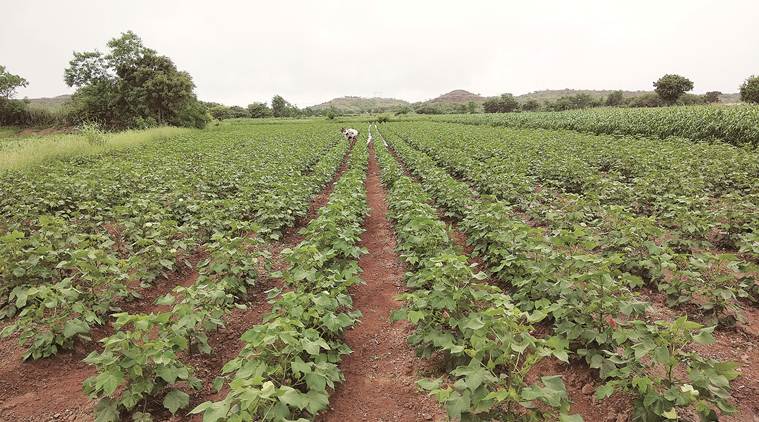- India
- International
Gujarat’s cotton farmers ward off pink bollworm
The insect pest, which wreaked havoc two years ago, is viewed today as a threat that can be ‘managed’.
 A farmer tending to his cotton crop in Vinchhiya taluka of Gujarat’s Rajkot district. (Photo: Gopal Kateshiya)
A farmer tending to his cotton crop in Vinchhiya taluka of Gujarat’s Rajkot district. (Photo: Gopal Kateshiya)
His entire crop was destroyed by pink bollworm larvae two year ago. But that hasn’t deterred Uday Khachar from growing cotton again. This kharif season, he has planted it on 20 out of his 24 hectares of arable land in Panchavada village in Chotila taluka of Gujarat’s Surendranagar district. And the dull white larva with a pink banding on its upper side, which chews through the lint to feed on the seeds of the raw cotton or kapas, is the least of his concerns.
“The insect attacked my crop first in 2015, but caused massive damage only the following year. But in 2017, there was no problem. This year, too, there has been no attack so far. Even if it happens, I should be able to control it by spraying insecticides available in the market. This looks to be one of the best crops I have had in recent years,” says the 40-year-old, Class X-pass farmer.
Khachar’s main worry is water. “I could sow after mid-June, as there was water that could be drawn from my three bore-wells. But the lack of rains has meant that my five open wells are not sufficiently recharged. The crop needs water now, when it has entered the flowering stage and boll formation, too, is taking place. The skies are overcast, but it is barely drizzling,” he sighs.
Ratibhai Patel, who has sown cotton on his entire six-hectare holding on the outskirts of Sayla town in Surendranagar, states that the pink bollworm has already struck, “but I have managed it by spraying three doses of profenophos and cypermethrin insecticides,”.
Gujarat is India’s largest cotton producer, accounting for 108 lakh bales (of 170 kg each) out of the total 365 lakh bales of lint output in 2017-18. Within Gujarat, over 70 per cent of production is from the Saurashtra region. This year, cotton acreage in the state has risen to 27 lakh hectares (lh), compared to 26.17 lh in 2017-18. Of the 27 lh, 19.26 lh has been sown in the 11 districts of Saurashtra: Amreli (4.04 lh), Surendranagar (3.44 lh), Rajkot (2.60 lh), Bhavnagar (2.25 lh), Morbi (2.18 lh), Jamnagar (1.84 lh), Botad (1.66 lh), Junagadh (76,100 hectares), Devbhoomi Dwarka (21,300 hectares), Gir Somnath (18,300 hectares) and Porbandar (10,700 hectares).

“After last year’s success in containing pink bollworm, farmers are confident about cotton, proof of which is the higher plantings. Profenophos, triazophos and cypermethrin are not new insecticides, but farmers have figured out how to use them at the right time. Their application can control infestation of up to 90 per cent,” notes Dinesh Pokiya, a farm input dealer in Babra town of Amreli district. However, he warns that spraying of chemicals is not 100 per cent effective, apart from being costly. Farmers should, hence, also try out other options such as placing pheromone and light traps to lure the insect pest.
According to LK Dhaduk, head of the Junagadh Cotton Research Station of Junagadh Agricultural University (JAU), pink bollworm was noticed for the first time in Gujarat in Amreli district’s Dhari and Savarkundla talukas during 2013. The larvae caused crop losses to the extent of 80 per cent in 2016. “But thanks to the collective efforts of farmers, seed companies, pesticide manufacturers, traders and scientists, we could control the pest last year,” Dhaduk tells The Indian Express.
Gujarat, like other states, mostly grows Bt cotton containing genes of the Bacillus thuringiensis soil bacterium coding for proteins toxic to various bollworms. At the time of its introduction in 2002, the Bt genes were fatal against a host of pests, including American bollworm, pink bollworm and tobacco cutworm. But pink bollworm developed resistance to the Bt toxins from around 2014. “It could have been delayed had farmers planted non-Bt varieties on the edge of Bt cotton fields, which is what Monsanto (the technology developer) had recommended. That would have acted as a refuge crop for the pest. Unfortunately, farmers did not follow the protocols, as yields from the non-Bt plants were lower. As a result, the insect and its progeny fed only on Bt cotton. That hastened the process of resistance to Bt toxins,” explains Dhaduk.
Another factor contributing to attacks has been early sowing by farmers. The pink bollworm moths become active with rising humidity levels, and they breed both during May-June and July-August. Early-sown cotton acts as a host for eggs laid by the first-generation moths. These eggs become larva within 4-5 days and subsequently develop into moths within a month. Those moths, in turn, lay eggs again in July-August, leading to a renewed attack on the crop.
“If farmers avoid sowing early, their crop can escape the first-generation larval attack. If sowing happens after mid-June, the second-generation larva can be controlled by pesticides. By not spraying these for the first-generation insects, their effectiveness will go up and the overall cost of application also comes down,” observes Dhaduk.
The scientist, nevertheless, believes that farmers need to be made to plant refuge crop. This has not been happening, as companies are now putting the non-Bt seeds in a separate small envelope within the main package containing Bt seeds. Therefore, farmers are able to identify the former and not plant them at all.
But the government, from the next season onwards, has made it mandatory for companies to mix 24 grams of non-Bt seeds along with 450 grams of Bt seeds. “Farmers will, then, be unable to separate the two and some refuge crop would get planted. Apart from refuge, we need to also promote other means of control such as pheromone traps,” adds Dhaduk.
For now, though, farmers are happy, with no signs of serious attack by the dreaded pest. Moreover, the price outlook also seems good. The kapas (raw un-ginned cotton) that has started arriving in the mandis of Punjab is selling at over Rs 5,600 per quintal, which is higher than the government’s minimum support price of Rs 5,150 for medium staple and Rs 5,450 for long staple varieties.
With the new cotton year from October projected to open with stocks of just 22 lakh bales, against 36.07 lakh bales in 2017-18, and the benchmark global Cotlook ‘A’ Index price, too, at 92.15 cents per pound — they ruled at 84.70 cents a year ago and around 75 cents two years ago — the coming months promise some hope.
Apr 19: Latest News
- 01
- 02
- 03
- 04
- 05






































